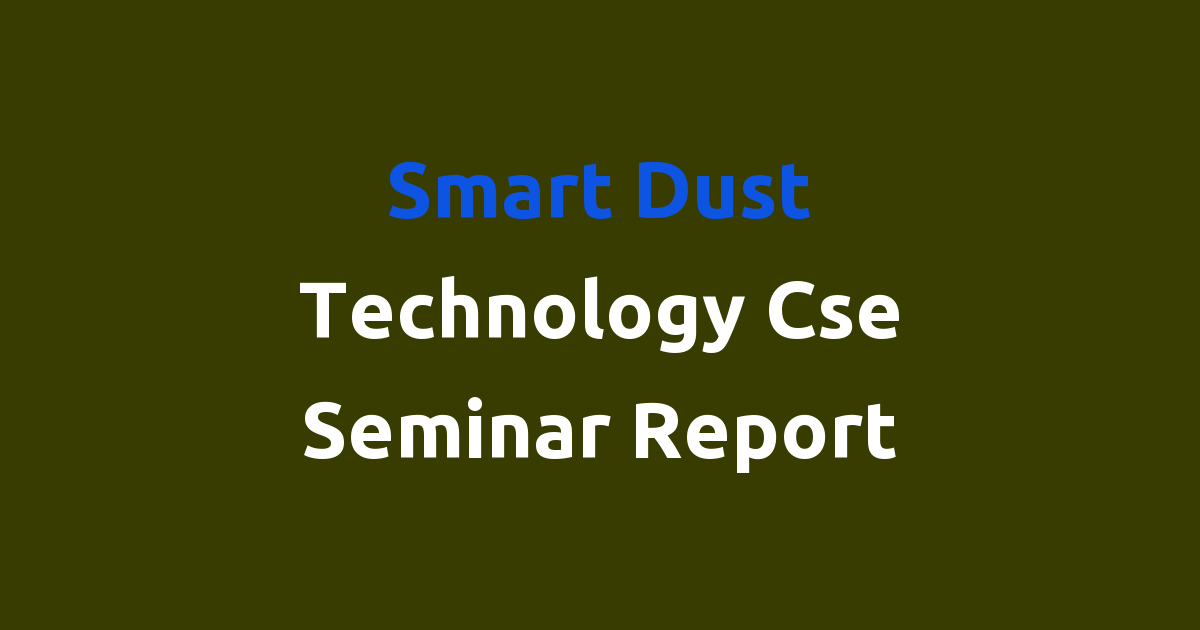Seminar report on smart dust technology for computer science engineering.
Smart Dust Technology CSE Seminar Report
Introduction
In recent years, the advancement of technology has led to the development of various innovative solutions to address modern challenges. One such groundbreaking technology is Smart Dust. Smart Dust refers to tiny wireless devices that can sense, compute, and communicate in the physical world. These microscopic devices, also known as motes, are equipped with sensors, microprocessors, and wireless communication capabilities, allowing them to collect and transmit data in real-time.
Problem Statement
Traditional monitoring systems are often bulky, expensive, and limited in their capabilities. This poses a challenge in environments where real-time monitoring is essential, such as industrial settings, environmental monitoring, and healthcare. The need for a more efficient and cost-effective solution has led to the development of Smart Dust technology.
Existing System
The current monitoring systems rely on large and centralized sensors that are often cumbersome to deploy and maintain. These systems are limited in their flexibility and scalability, making it difficult to adapt to changing environments and requirements. Furthermore, the high cost of traditional monitoring systems makes it challenging to implement widespread deployment in various applications.
Disadvantages
Some of the disadvantages of the existing monitoring systems include:
– Large and bulky sensors
– High costs of deployment and maintenance
– Limited scalability and flexibility
– Inefficient data collection and transmission
– Limited battery life
Proposed System
The proposed system involves the use of Smart Dust technology to overcome the limitations of traditional monitoring systems. By leveraging the capabilities of Smart Dust devices, we can create a more efficient, cost-effective, and scalable monitoring solution. These tiny devices can be easily deployed in large numbers to cover a wide area, enabling real-time data collection and communication.
Advantages
Some of the advantages of the proposed Smart Dust technology include:
– Small and lightweight devices
– Low cost of deployment and maintenance
– High scalability and flexibility
– Real-time data collection and communication
– Extended battery life
Features
The Smart Dust technology offers several key features that make it an ideal solution for various monitoring applications:
– Sensor capabilities: Smart Dust devices are equipped with sensors for collecting data on various parameters such as temperature, humidity, and pressure.
– Communication capabilities: Smart Dust devices can communicate wirelessly with each other and with external systems, enabling real-time data transmission.
– Energy efficiency: Smart Dust devices are designed to operate on minimal power, extending their battery life and enabling long-term deployment.
– Scalability: Smart Dust technology can be easily scaled up by deploying additional devices to cover larger areas or increase monitoring capabilities.
– Adaptability: Smart Dust devices can be reconfigured and reprogrammed to adapt to changing environments and requirements, making them highly versatile.
Conclusion
In conclusion, Smart Dust technology offers a promising solution for addressing the limitations of traditional monitoring systems. By leveraging the capabilities of tiny wireless devices, we can create a more efficient, cost-effective, and scalable monitoring solution for various applications. The advantages of Smart Dust technology, such as small form factor, low cost, high scalability, and real-time data collection, make it an ideal choice for modern monitoring requirements. With further research and development, Smart Dust technology has the potential to revolutionize the way we monitor and analyze data in the physical world.

